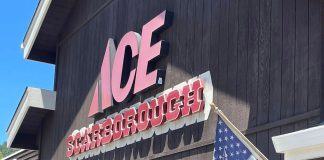San Lorenzo Valley Water District customers can expect their monthly bills to increase thanks to the recently adopted CZU wildfire recovery surcharge.
Beginning on Aug. 20, customers will see an increase of approximately $10 per billing cycle for the next five years.
Director Bob Fultz was the lone dissenting voice when the item came to the SLVWD Board of Directors, and he was vocal in his opposition based on the impact the monthly surcharge would have on its ratepayers.
“I absolutely respect the impulse for a community to pull together after a tragedy like the CZU fire, to look for common ground and sensible solutions, and I’m mindful that these last 18 months have really been difficult for our customers. If we could have done something else to lessen the burden on ratepayers, I believe the board would have,” Fultz said.
Director Jayme Ackemann said that because of the dual disasters, the CZU Complex and ongoing pandemic, “asking our community to pay a surcharge wasn’t an easy decision for the board.”
“But long term it would be far more expensive and potentially damaging to the water system’s integrity if these projects aren’t funded and completed soon,” she said in a statement. “The state of California is deep into one of the driest periods in our state’s history. Failing to restore our ability to maximize our water sources could have unintended consequences if we have a prolonged period of drought, that’s why I voted to support the fire recovery surcharge.”
The move toward the surcharge was precipitated by the passage of Proposition 218, which expands California residents’ power to challenge local revenue-raising measures. Prop 218 empowers residents to reject, repeal or reduce any local tax, assessment or fee. District Manager Rick Rogers reminded residents that the surcharge can be reduced or withdrawn entirely at the board’s discretion based on the fiscal health of the utility.
“There is some language in Proposition 218 that leaves a lot of details to the discretion of the board,” Fultz said.
Ultimately, the ratepayers determine whether or not the surcharge will be accepted by the board based on the community’s response to the proposal. The Aug. 5 board meeting included a public hearing on the wildfire recovery surcharge. After the hearing, the protest ballots for the increase were counted. Of the 3,866 ballots needed to stymie the proposal, only 547 were received by the Aug. 5 deadline, allowing the surcharge to easily pass and be ratified by the board. That move, says fiscal conservative Fultz, is just one domino in a larger game of numbers.
The Federal Emergency Management Agency, or FEMA, will pay 75% of replacement costs for the estimated $20 million of damage caused by the CZU fire, leaving the district responsible for 25% of the financial burden. But Fultz says that number could have been reduced dramatically.
“It’s entirely possible that with grants and funding available to the district, our financial responsibility could be reduced from 25% to 6.8% depending on the influx of funds,” Fultz said.
Were that to happen, says Fultz, the surcharge might be reduced, or the term of the agreement might be lessened. Either way, Fultz is looking for ways to reduce the impact on the district’s customers.
One of the big concerns for the fire recovery plan includes the reinstallation of the raw water pipeline. The original plastic-pipe-above-ground method proved to be disastrous when the CZU fires swept through the area; installing the same pipe in the same way without hardening, or protecting, the pipeline will leave the district and its customers vulnerable should another fire overtake the area.
“Although the fire burned some areas, there is still plenty of fuel ready to ignite in the mountains,” Fultz said. “We need to be thinking ahead when we rebuild, and we have some tough decisions ahead.”
Fultz says he’s thinking ahead, too, when it comes to the district’s approved budget. Operating expenses, he says, have increased at a rate of about 7% per year for the last eight years. If SLVWD had changed its rate of operating expense growth from 7.1% to 5.5%, he explained, it could have saved roughly $2.5 million over the last five years—possibly cutting the surcharge in half.
“These aren’t operating expenses related to the fire or to the pandemic; this has been a consistent rate of growth over a long period of time,” he said. “If you go back 25 years, we’ve averaged 6.8% annually. This isn’t related to our current circumstances; this is something that’s been in play for years, and the board is going to have to make some tough decisions about how to bring in the money needed to support capital improvements and other fiduciary responsibilities. The recently approved budget reflects another pending rate increase in 2022/2023, and our customers need to be prepared for what’s coming.”
Having trouble paying your water bill? Visit www.slvwd.com and enter “Rate Assistance Program” in the search bar.








